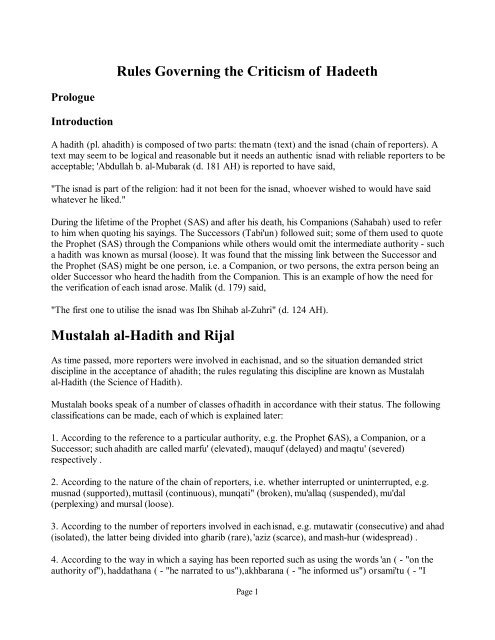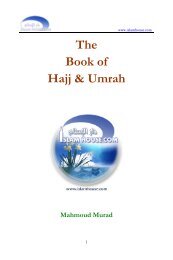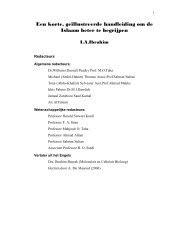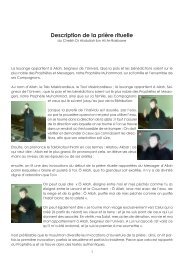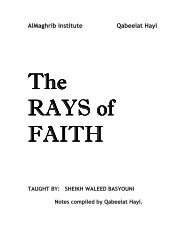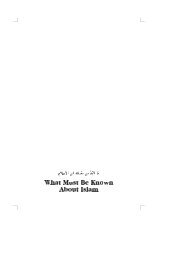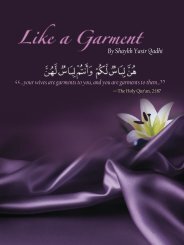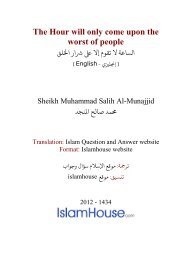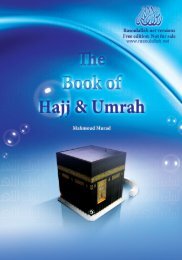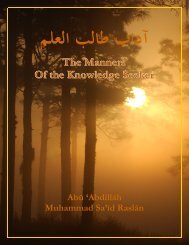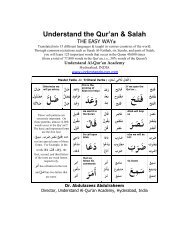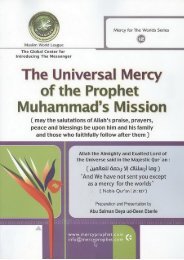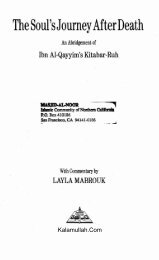Rules Governing The Criticism Of Hadith - Islam House
Rules Governing The Criticism Of Hadith - Islam House
Rules Governing The Criticism Of Hadith - Islam House
Create successful ePaper yourself
Turn your PDF publications into a flip-book with our unique Google optimized e-Paper software.
Prologue<br />
Introduction<br />
<strong>Rules</strong> <strong>Governing</strong> the <strong>Criticism</strong> of Hadeeth<br />
A hadith (pl. ahadith) is composed of two parts: the matn (text) and the isnad (chain of reporters). A<br />
text may seem to be logical and reasonable but it needs an authentic isnad with reliable reporters to be<br />
acceptable; 'Abdullah b. al-Mubarak (d. 181 AH) is reported to have said,<br />
"<strong>The</strong> isnad is part of the religion: had it not been for the isnad, whoever wished to would have said<br />
whatever he liked."<br />
During the lifetime of the Prophet (SAS) and after his death, his Companions (Sahabah) used to refer<br />
to him when quoting his sayings. <strong>The</strong> Successors (Tabi'un) followed suit; some of them used to quote<br />
the Prophet (SAS) through the Companions while others would omit the intermediate authority - such<br />
a hadith was known as mursal (loose). It was found that the missing link between the Successor and<br />
the Prophet (SAS) might be one person, i.e. a Companion, or two persons, the extra person being an<br />
older Successor who heard the hadith from the Companion. This is an example of how the need for<br />
the verification of each isnad arose. Malik (d. 179) said,<br />
"<strong>The</strong> first one to utilise the isnad was Ibn Shihab al-Zuhri" (d. 124 AH).<br />
Mustalah al-<strong>Hadith</strong> and Rijal<br />
As time passed, more reporters were involved in each isnad, and so the situation demanded strict<br />
discipline in the acceptance of ahadith; the rules regulating this discipline are known as Mustalah<br />
al-<strong>Hadith</strong> (the Science of <strong>Hadith</strong>).<br />
Mustalah books speak of a number of classes of hadith in accordance with their status. <strong>The</strong> following<br />
classifications can be made, each of which is explained later:<br />
1. According to the reference to a particular authority, e.g. the Prophet (SAS), a Companion, or a<br />
Successor; such ahadith are called marfu' (elevated), mauquf (delayed) and maqtu' (severed)<br />
respectively .<br />
2. According to the nature of the chain of reporters, i.e. whether interrupted or uninterrupted, e.g.<br />
musnad (supported), muttasil (continuous), munqati'' (broken), mu'allaq (suspended), mu'dal<br />
(perplexing) and mursal (loose).<br />
3. According to the number of reporters involved in each isnad, e.g. mutawatir (consecutive) and ahad<br />
(isolated), the latter being divided into gharib (rare), 'aziz (scarce), and mash-hur (widespread) .<br />
4. According to the way in which a saying has been reported such as using the words 'an ( - "on the<br />
authority of"), haddathana ( - "he narrated to us"), akhbarana ( - "he informed us") or sami'tu ( - "I<br />
Page 1
heard"). In this category falls the discussion about mudallas (concealed) and musalsal (connected)<br />
ahadith.<br />
5. According to the nature of the matn and isnad, e.g. an addition by a reliable reporter, known as<br />
ziyadah thiqa, or opposition by a lesser authority to a more reliable one, known as shadh (aloof). In<br />
some cases a text containing a vulgar expression, unreasonable remark or an apparently erroneous<br />
statement is rejected by the traditionists outright without consideration of the isnad. Such a hadith is<br />
known as munkar (denounced). If an expression or statement is proved to be an addition by a reporter<br />
to the text, it is declared as mudraj (added).<br />
6. According to a hidden defect found in the isnad or text of a hadith. Although it could be included<br />
in some of the previous categories, hadith mu'allal (defective hadith) is worthy to be explained<br />
separately. <strong>The</strong> defect can be caused in many ways; e.g. two types of hadith mu'allal are known as<br />
maqlub (overturned) and mudtarib (shaky).<br />
7. According to the reliability and memory of the reporters; the final verdict on a hadith depends<br />
mainly on this classification: verdicts such as sahih (sound), hasan (good), da'if (weak) and maudu'<br />
(fabricated) rest mainly upon the nature of the reporters in the isnad.<br />
Musatalah al-hadith is strongly associated with Rijal al-hadith (the study of the reporters of hadith). In<br />
scrutinising the reporters of a hadith, authenticating or disparaging remarks made by recognised<br />
experts, whether among the Successors or those after them, were found to be of great help. <strong>The</strong><br />
earliest remarks cited in the books of Rijal go back to a host of Successors and those after during the<br />
first three centuries of <strong>Islam</strong>. A list of such names is provided by the author in his thesis, <strong>Criticism</strong> of<br />
<strong>Hadith</strong> among Muslims with reference to Sunan lbn Maja, at the end of chapters IV, V and VI.<br />
Among the earliest available works in this field are Tarikh of Ibn Ma'in (d. 233), Tabaqat of Khalifa b.<br />
Khayyat (d. 240), Tarikh of Bukhari (d. 256), Kitab al-Jarh wa al-Ta'dil of Ibn Abi Hatim (d. 327) and<br />
Tabaqat of Muhammad b. Sa'd al-Zuhri (d. 320).<br />
A number of traditionists made efforts specifically for the gathering of information about the reporters<br />
of the five famous collections of hadith: those of Bukhari (d. 256), Muslim (d. 261), Abu Dawud (d.<br />
275), Tirmidhi (d. 279) and Nasa'i (d. 303), giving authenticating and disparaging remarks in detail.<br />
<strong>The</strong> first major such work to include also the reporters of Ibn Maja (d. 273) is the ten-volume<br />
collection of al-Hafiz 'Abd al-Ghani al-Maqdisi (d. 600), known as Al-Kamal fi Asma' al-Rijal. Later,<br />
Jamal al-Din 'Abd al-Hajjaj Yusuf b. 'Abd al-Rahman al-Mizzi (d. 742) prepared an edited and<br />
abridged version of this work, but made a number of additions and punctuation of the names by<br />
names, places and countries of origin of the reporters. He named it Tahdhib al-Kamal fi Asma' al-Rijal<br />
and produced it in twelve volumes. Further, one of al-Mizzi's gifted pupils, Shams al-Din Abu<br />
'Abdullah Muhammad b. Ahmad b. 'Uthman b. Qa'imaz al-Dhahabi (d. 748), summarised his shaikh's<br />
work and produced two abridgements: a longer one called Tadhhib al-Tahdhib and a shorter one<br />
called Al-Kashif fi Asma' Rijal al-Kutub al-Sitta.<br />
A similar effort with the work of Mizzi was made by Ibn Hajar (d. 852), who prepared a lengthy but<br />
abridged version, with about one-third of the original omitted, entitled Tahdhib al-Tahdhib in twelve<br />
shorter volumes. Later, he abridged this further to a relatively humble two-volume work called Taqrib<br />
al-Tahdhib.<br />
Page 2
<strong>The</strong> work of Dhahabi was not left unedited; Khazraji (Saif al-Din Ahmad b. 'Abdullah, d. after 923)<br />
summarised it and also made valuable additions, producing his Khulasa.<br />
A number of similar works deal with either trustworthy authorities, e.g. Kitab al-Thiqat by 'Ijli (d.<br />
261) and Tadhkira al-Huffaz by Dhahabi, or with disparaged authorities, e.g. Kitab al-Du'afa' wa<br />
al-Matrukin by Nasa'i and Kitab al-Majruhin by Muhammad b. Hibban al-Busti (d. 354).<br />
Two more works in this field, which include a large number of reporters, both authenticated and<br />
disparaged, are Mizan al-l'tidal of Dhahabi and Lisan al-Mizan of Ibn Hajar.<br />
<strong>The</strong> Classification of Hadeeth - According to the reference to a<br />
particular authority<br />
<strong>The</strong> following principal types of hadith are important:<br />
Marfu':<br />
A hadith referred back to the Prophet, e.g. a reporter (whether a Companion, Successor or other) says,<br />
"<strong>The</strong> Messenger of Allah said ..."<br />
Mauquf:<br />
A hadith referred back to a Companion, e.g. "Ibn 'Abbas said ...", without being attributed to the<br />
Prophet.<br />
Maqtu':<br />
A hadith referred back to a Successor, e.g. "Al-Hasan al-Basri said ..."<br />
<strong>The</strong> authenticity of each of these three types of hadith depends on other factors such as the reliability<br />
of its reporters, the nature of linkage among them, etc. However, the above classification is extremely<br />
useful since through it the sayings of the Prophet can be distinguished at once from those of<br />
Companions or Successors; this is especially helpful in debate in matters of fiqh.<br />
Imam Malik's al-Muwatta', one of the early collections of hadith, contains a relatively even ratio of<br />
these types of hadith, as well as mursal ahadith (which are discussed below). According to Abu Bakr<br />
al-Abhari (d. 375), al-Muwatta' contains the following:<br />
600 marfu' ahadith, 613 mauquf ahadith, 285 maqtu' ahadith, and 228 mursal ahadith; a total of 1726<br />
ahadith.<br />
Among other collections, relatively more mauquf and maqtu' ahadith are found in al-Musannaf of Ibn<br />
Abi Shaiba (d. 235), al-Musannaf of 'Abd al-Razzaq (d. 211) and the Tafsirs of Ibn Jarir (d. 310), Ibn<br />
Abi Hatim (d. 327) and Ibn al-Mundhir (d. 319).<br />
Page 3
<strong>The</strong> Classification of Hadeeth - According to the link found<br />
among the reporters<br />
<strong>The</strong> following categories fall under this heading:<br />
Musnad<br />
Al-Hakim defines it as follows:<br />
"A hadith which a traditionist reports from his shaikh from whom he is known to have heard (ahadith)<br />
at a time of life suitable for learning, and similarly in turn for each shaikh, until the isnad reaches a<br />
well-known Companion who turn reports from the Prophet."<br />
By this definition, an ordinary muttasil hadith (i.e. one with an uninterrupted isnad) is excluded if it<br />
goes back only to a Companion or Successor, as is a marfu' hadith which has an interrupted isnad.<br />
Al-Hakim gave the following example of a musnad hadith:<br />
We reported from Abu 'Amr 'Uthman b. Ahmad al-Sammak al-Baghdadi === Al-Hasan b. Mukarram<br />
=== 'Uthman b. 'Amr === Yunus --- al-Zuhri --- 'Abdullah b. Ka'b b. Malik --- his father, who asked<br />
Ibn Abi Hadrad for payment of a debt he owed to him, in the mosque. During the argument, their<br />
voices were raised until heard by the Messenger of Allah who eventually lifted the curtain of his<br />
apartment and said, "O Ka'b! Write off a part of your debt." He meant remission of half of it. So he<br />
agreed and the man paid him.<br />
Al-Hakim then remarks,<br />
"Now, my hearing from Ibn al-Simak is well-known, as is his from Ibn Mukarram. Al-Hasan's link<br />
with 'Uthman b. 'Amr and the latter's with Yunus b. Zaid are known as well. Yunus is always<br />
remembered with al-Zuhri, and the latter with the sons of Ka'b b. Malik, whose link to their father<br />
and his companionship of the Prophet are well-established."<br />
<strong>The</strong> term musnad is applied also to those collections of ahadith which give the ahadith of each<br />
Companion separately. Among the early compilers of such a Musnad were Yahya b. 'Abd al-Hamid<br />
al-Himmani (d. 228) at Kufa and Musaddad b. Musarhad (d. 228) at Basra. <strong>The</strong> largest existing<br />
collection of ahadith of Companions arranged in this manner is that of Imam Ahmad b. Hanbal (d.<br />
241), which contains around thirty thousand ahadith. Another larger work is attributed to the famous<br />
Andalusian traditionist Baqi b. Makhlad al-Qurtubi (d. 276), but unfortunately it is now untraceable.<br />
Mursal, Munqati', Mu'dal, and Mu'allaq ahadith<br />
Page 4
If the link between the Successor and the Prophet is missing, the hadith is mursal. In other words,<br />
when a Successor says, "<strong>The</strong> Prophet said ...".<br />
However, if a link anywhere before the Successor (i.e. closer to the traditionist recording the hadith)<br />
is missing, the hadith is munqati'. This applies even if there is an apparent link, e.g. a reporter says, "A<br />
shaikh or a man reported to me ..." without naming this authority, or when an isnad is apparently<br />
muttasil (uninterrupted) but in reality a reporter is found not to have heard from his shaikh.<br />
If the number of missing reporters in the isnad exceeds one, the isnad is mu'dal. If the reporter omits<br />
the whole isnad and quotes the Prophet directly (i.e. the link is missing at the beginning, unlike the<br />
case with a mursal isnad), the hadith is called mu'allaq (hanging); sometimes it is known as balaghat.<br />
For example, Malik says, "It reached me that the Messenger of Allah said ..."<br />
Authenticity of the Mursal <strong>Hadith</strong><br />
<strong>The</strong>re has been a great deal of discussion regarding the authenticity of the Mursal <strong>Hadith</strong>, since it is<br />
quite probable that a Successor might have omitted two names, those of an elder Successor and a<br />
Companion, rather than just one name, that of a Companion.<br />
If the Successor is known to have omitted the name of a Companion only, then the hadith is held to<br />
be authentic, for a Successor can only report from the Prophet through a Companion; the omission of<br />
the name of the Companion does not affect the authenticity of the isnad since all Companions are<br />
held to be trustworthy and reliable, both by Qur'anic injunctions and sayings of the Prophet.<br />
However, opinions vary in the case where the Successor might have omitted the names of two<br />
authorities:<br />
(i) <strong>The</strong> Marasil of elder Successors such as Sa'id b. al-Musayyab and 'Ata' b. Abi Rabah are acceptable<br />
because all their Marasil, after investigation, are found to come through the Companions only.<br />
However, the Marasil of younger Successors are only acceptable if the names of their immedeiate<br />
authorities are known through different sources; if not, they are rejected outright.<br />
(ii) <strong>The</strong> Marasil of Successors and those who report from them are acceptable without any<br />
investigation at all. This opinion is strongly supported by the Kufi school of traditionists.<br />
To be precise in this issue, let us investigate in detail the various opinions regarding the Mursal<br />
<strong>Hadith</strong>:<br />
1) Ibn 'Abd al-Barr (d. 463) says that the opinion held by Imam Malik and all jurists of their school is<br />
that the Mursal of a trustworthy person is valid as proof and as justification for a practice, just like a<br />
musnad hadith.<br />
To some jurists, such as the Malikiyya, the Mursal is better than the Musnad. <strong>The</strong>ir reasoning is as<br />
follows:<br />
Page 5
"the one who reports a musnad hadith leaves you with the names of the reporters for further<br />
investigation and scrutiny, while the one who narrates by way of Irsal, being a knowledgeable and<br />
trustworthy person himself, has already done so and the hadith is sound. In fact, he saves you from<br />
further research."<br />
2) Abu Hanifa (d. 150) holds the same opinion as Malik; he accepts the Mursal <strong>Hadith</strong> whether or not<br />
it is supported by another hadith.<br />
3) Al-Shafi'i (d. 204) has discussed this issue in detail in his al-Risala; he requires the following<br />
conditions to be met before accepting a mursal hadith:<br />
(i) In the narrative, he requires that one of the following conditions be met:<br />
that it be reported also as musnad through another isnad;<br />
that its contents be reported as mursal through another reliable source with a different isnad;<br />
that the meaning be supported by the sayings of some Companions; or<br />
that most scholars hold the same opinion as conveyed by the mursal hadith.<br />
(ii) Regarding the narrator, he requires that one of the following conditions be met:<br />
he be an elder Successor;<br />
if he names the missing person in the isnad, he does not usually name an unknown person or<br />
someone not suitable for reporting from acceptably; or<br />
he does not contradict a reliable person when he happens to share with him in a narration.<br />
On the basis of these arguments, al-Shafi'i accepts the Irsal of Sa'id b. al-Musayyab, one of the elder<br />
Successors. For example, al-Shafi'i considers the issue of selling meat in exchange for a living animal.<br />
He says that Malik told him, reporting from Zaid b. Aslam, who reported from Ibn al-Musayyab that<br />
the Messenger of Allah forbade the selling of meat in exchange for an animal. He then says, "This is<br />
our opinion, for the Irsal of Ibn al-Musayyib is sound."<br />
4) Ahmad b. Hanbal (d. 241), according to Ibn Qayyim, accepts mursal and da'if ahadith if nothing<br />
opposing them is found in a particular issue, preferring them to analogy. He classifies ahadith into<br />
sahih and da'if only rather into sahih, hasan and da'if, the preference of most later traditionists.<br />
Consequently, a da'if hadith may stand close to sahih in the opinion of Ahmad because of the grading<br />
of the Mursal <strong>Hadith</strong> in fourth position, unlike Malik who regards mursal as equal to musnad.<br />
5) Ibn Hazm (d. 456) rejects the Mursal <strong>Hadith</strong> outright; he says that the Mursal is unacceptable,<br />
whether it comes through Sa'id b. al-Musayyib or al-Hasan al-Basri. To him, even the Mursal of a<br />
Companion who was not well-known among the Companions is unacceptable.<br />
6) Abu Dawud (d . 275) accepts the Mursal with two conditions:<br />
a) that no musnad hadith is found regarding that issue; and<br />
b) that if a musnad hadith is found, it is not contradicted by the mursal hadith.<br />
Page 6
7) Ibn Abi Hatim (d. 327) does not give a specific opinion about the Mursal <strong>Hadith</strong>. However, he did<br />
collect an anthology of 469 reporters of hadith, including four female reporters, whose narratives were<br />
subjected to criticism due to Irsal. This collection is known as Kitab al-Marasil.<br />
8) Al-Hakim (d. 405) is extremely reluctant to accept the Mursal except in the case of elder<br />
Successors. He holds, on the basis of the Qur'an, that knowledge is based on what is heard and not on<br />
what is reported. In this regard, he quotes Yazid b. Harun who asked Hammad b. Laith:<br />
"O Abu Isma'il! Did Allah mention the people of <strong>Hadith</strong> in the Qur'an?" He replied, "Yes! Did you<br />
not hear the saying of Allah,<br />
If a party from every expedition remained behind, they could devote themselves to studies in religion<br />
and admonish the people when they return to them, that thus they (may learn) to guard themselves<br />
(against evil)' (Q., 9:l22).<br />
This concerns those who set off to seek knowledge, and then return to those who remained behind in<br />
order to teach them."<br />
Al-Hakim then remarks:<br />
"This verse shows that the acceptable knowledge is the one which is being heard, not just received by<br />
way of Irsal."<br />
9) Al-Khatib al-Baghdadi (d. 462) strongly supports the view of those who reject the Mursal except if<br />
it comes through elder Successors. He concludes, after giving a perusal of different opinions about<br />
this issue:<br />
"What we select out of these sayings is that the Mursal is not to be practised nor is it acceptable as<br />
proof. We say that Irsal leads to one reporter being ambiguous; if he is ambiguous, to ascertain his<br />
reliability is impossible. We have already explained that a narration is only acceptable if it comes<br />
through a reporter known for reliability. Hence, the Mursal should not be accepted at all."<br />
Al-Khatib gives the following example, showing that a narrative which has been reported through<br />
both musnad and mursal isnads is acceptable, not because of the reliability of those who narrated it by<br />
way of Irsal but because of an uninterrupted isnad, even through less reliable reporters:<br />
<strong>The</strong> text of the hadith is: "No marriage is valid except by the consent of the guardian"; al-Khatib gives<br />
two isnads going back to Shu'ba and Sufyan al-Thauri; the remainder of each isnad is: Sufyan<br />
al-Thauri and Shu'ba --- Abu Ishaq --- Abu Barda --- the Prophet.<br />
This isnad is mursal because Abu Burda, a Successor, narrates directly from the Prophet. However,<br />
al-Khatib gives three isnads going back to Yunus b. Abi Ishaq, Isra'il b. Yunus and Qais b. al-Rabi';<br />
the remainder of the first isnad is: Yunus b. Abi Ishaq --- Abu Ishaq --- Abu Burda --- Abu Musa ---<br />
the Prophet. <strong>The</strong> other two reporters narrate similarly, including the name of Abu Musa, the<br />
Companion from whom Abu Burda has reported.<br />
Al-Khatib further proves that both al-Thauri and Shu' ba heard this hadith from Abu Ishaq in one<br />
Page 7
sitting while the other three reporters listened to him in different sittings. Hence this addition of Abu<br />
Musa in the isnad is quite acceptable.<br />
10) Ibn al-Salah (d. 643) agrees with al-Shafi'i in rejecting the Mursal <strong>Hadith</strong> unless it is proved to<br />
have come through a musnad route.<br />
11) Ibn Taimiyya (d. 728) classifies Mursal into three categories. He says,<br />
"<strong>The</strong>re are some acceptable, others unacceptable, and some which require further investigation: if it is<br />
known that the reporter does so (i.e. narrates by Irsal) from reliable authorities, then his report will be<br />
accepted; if he does so from both classes of authorities, i.e. reliable and unreliable, we shall cease to<br />
accept his narration if it is proved that sometimes he reports from unknown authorities as well. All<br />
such mursal ahadith which go against the reports made by reliable authorities will be rejected<br />
completely."<br />
12) Al-Dhahabi (d. 748) regards the Mursal of younger Successors such as al-Hasan al-Basri, al-Zuhri,<br />
Qatada and Humaid al-Tawil as the weakest type of Mursal.<br />
Later scholars such as Ibn Kathir (d. 744), al-'Iraqi (d. 806), Ibn Hajar (d. 852), al-Suyuti (d. 910),<br />
Muhammad b. Ibrahim al-Wazir (d. 840), Tahir al-Jaza'iri (d. 1338) and Jamal al-Din al-Qasmi (d.<br />
1332) have given exhaustive discussions about this issue, but none of them holds an opinion different<br />
to those mentioned above.<br />
<strong>The</strong> Classification of Hadeeth - Mutawatir and Ahad ahadith<br />
Depending on the number of the reporters of the hadith, it can be classified into the general categories<br />
of mutawatir or ahad hadith.<br />
A mutawatir hadith is one which is reported by such a large number of people that they cannot be<br />
expected to agree upon a lie, all of them together.<br />
Al-Ghazali (d. 505) stipulates that a mutawatir narration be known by the great number of its<br />
reporters equally in the beginning, in the middle and at the end. He is correct in this stipulation<br />
because some narrations, although known as mutawatir among some people, whether Muslims or<br />
non-Muslims, have no tawatur in the beginning .<br />
Examples of mutawatir practices are the five daily prayers, fasting, zakat, the Hajj and recitation of<br />
the Qur'an. Among the verbal mutawatir ahadith, the following has been reported by more than<br />
sixty-two Companions and has been widely known among the Muslims throughout the ages:<br />
"Whoever lies about me intentionally, let him reserve his seat in the Fire."<br />
Ahadith related to the description of the Haud Kauthar (the Basin of Abundance) in the Hereafter,<br />
raising the hands at certain postures during prayer, rubbing wet hands on the leather socks during<br />
Page 8
ablution, revelation of the Qur'an in seven modes, and the prohibition of every intoxicant are further<br />
examples of verbal mutawatir ahadith.<br />
A hadith ahad or khabar wahid is one which is narrated by people whose number does not reach that<br />
of the mutawatir case. Ahad is further classified into mashhur, 'aziz and gharib.<br />
A hadith is termed gharib when a single reporter is found relating it, usually at the beginning of the<br />
isnad (i.e., only one Companion relates it from the Prophet). For example, the saying of the Prophet,<br />
"Travel is a part of torment" is gharib; the isnad of this hadith contains only one reporter in each stage:<br />
Malik --- Yahya b. Abi Salih --- Abu Huraira --- <strong>The</strong> Prophet. With regard to its isnad, this hadith is<br />
sahih, although most gharib ahadith are weak; Ahmad b. Hanbal said, "Do not write these gharib<br />
ahadith because they are munkar and most of them are weak."<br />
A type of hadith similar to gharib is al-afrad (the solitary ones); it is known in three ways:<br />
(i) Similar to gharib, i.e. a single person is found reporting it from a well-known Imam.<br />
(ii) People of one locality are known to narrate a hadith.<br />
(iii) People of one locality are known to report a hadith from the people of another locality, such as<br />
Makkan people reporting from Madinan.<br />
If at any stage in the isnads, only two reporters are found to narrate the hadith, it is termed 'aziz. For<br />
example, Anas reported that the Messenger of Allah said,<br />
"None of you believes until I become more beloved to him than his own son, his father and all<br />
mankind."<br />
Two reporters, Qatada and 'Abdul 'Aziz b. Shu'aib, report this hadith from Anas, and two more<br />
reporters narrate from each of them: Shu'ba and Sa'id report from Qatada, and Isma'il b. Ulayya and<br />
'Abd al-Warith from 'Abd al-'Aziz. <strong>The</strong>n a group of people report from each of them.<br />
A hadith which is reported by more than two reporters is known as mashhur. According to some<br />
scholars, every narrative which comes to be known widely, whether or not it has an authentic origin,<br />
is called mashhur. A mashhur hadith might be reported by only one or two reporters in the beginnning<br />
but become widely-known later, unlike gharib or 'aziz, which are reported by one or two reporters in<br />
the beginning and continue to have the same number even in the times of the Successors and those<br />
after them. For example, if only one or two reporters are found narrating hadith from a reliable<br />
authority in <strong>Hadith</strong> such as al-Zuhri and Qatada, the hadith will remain either gharib or 'aziz. On the<br />
other hand, if a group of people narrate from them it will be then known as mashhur. An example of a<br />
mashhur hadith is the famous saying of the Prophet,<br />
"Actions are (judged) according to their intentions."<br />
According to al-'Ala'i (Abu Sa'id Khalil Salah al-Din; d. 761), a hadith may be known as 'aziz and<br />
mashhur at the same time. By this he means a hadith which is left with only two reporters in its isnad<br />
Page 9
at any stage while it enjoys a host of reporters in other stages, such as the saying of the Prophet,<br />
"We are the last but (will be) in the first (rank) on the Day of Resurrection."<br />
This hadith is 'aziz in its first stage, as it is reported by Hudhaifa b. al-Yaman and Abu Huraira only.<br />
Later it becomes mashhur as seven people report it from Abu Huraira.<br />
<strong>The</strong> Classification of Hadeeth - According to the manner in<br />
which the hadith is reported<br />
Different ways of reporting, e.g. (he narrated to us),<br />
(he informed us), (I heard), and (on the authority of) are used by the reporters of hadith. <strong>The</strong> first three<br />
usually indicate that the reporter heard in person from his shaikh. <strong>The</strong> mode can denote either hearing<br />
in person or through another reporter.<br />
Tadlis (concealing) refers to an isnad where a reporter may have concealed the identity of his shaikh.<br />
Ibn al-Salah describes two types of Tadlis:<br />
a) Tadlis al-Isnad; A person reports from his shaikh, whom he met, what he did not hear from him, or<br />
from a contemporary of his whom he did not meet, in such a way as to create the impression that he<br />
heard the hadith in person.<br />
A mudallis normally uses the mode or to conceal the truth about the isnad.<br />
b) Tadlis al-Shuyukh: <strong>The</strong> reporter does mention his shaikh by his usual name, but instead with a less<br />
well-known name, by-name, nickname or another less well-known identity, in order not to disclose his<br />
shaikh's identity.<br />
Al-'Iraqi (d. 806), in his notes on Muqaddima Ibn al-Salah, adds a third type of Tadlis, known as<br />
Tadlis al-Taswiyya. To explain it, let us assume an isnad which contains a trustworthy shaikh<br />
reporting from a weak authority, who in turn reports from another trustworthy shaikh. Now, the<br />
reporter of this isnad omits the intermediate weak authority, leaving the isnad apparently consisting of<br />
reliable authorities. He plainly shows that he heard it from his shaikh but he uses the mode 'an to link<br />
his immediate shaikh with the next trustworthy one, thus omitting the intermediate authority. To an<br />
average reader, this isnad seems free of any doubt or discrepancy. This is known to have been<br />
practised by Baqiyya b. al-Walid, Walid b. Muslim, A'mash and al-Thauri. It is said to be the worst<br />
among the three kinds of Tadlis.<br />
Ibn Hajar (d. 852) classifies the mudallisun into five categories in his essay Tabaqat al-Mudallisin:<br />
a) Those who are known to do it occasionally, such as Yahya b. Sa'id al-Ansari.<br />
b) Those who are accepted by the traditionists, either because of their good reputation and relatively<br />
Page 10
few cases of Tadlis, e.g. al-Thauri, or because they reported from authentic authorities only, e.g. Ibn<br />
'Uyaina.<br />
c) Those who practised it a great deal. <strong>The</strong> traditionists have accepted only such ahadith from them<br />
which were reported with a clear mention of hearing directly. Among these are Abu Zubair al-Makki.<br />
Opinions differ regarding whether they are acceptable or not.<br />
d) Similar to the previous category, but the traditionists agree that their ahadith are to be rejected<br />
unless they clearly admit of their hearing, such as Baqiyya b. al-Walid.<br />
e) Those who are disparaged due to another reason apart from Tadlis; their ahadith are rejected, even<br />
though they admit of hearing them directly. Exempted from them are reporters such as Ibn Lahi'a,<br />
whose weakness is found to be of a lesser degree. Ibn Hajar gives the names of 152 such reporters.<br />
Tadlis, especially of those in the last three categories, is so disliked that Shu'ba said, "Tadlis is the<br />
brother of lying" and "To commit adultery is more favourable to me than to report by way of Tadlis."<br />
A musalsal (continued) isnad is one in which all the reporters as well as the Prophet use the same<br />
mode of transmission such as 'an, haddathana, etc., repeat any other additional statement or remark, or<br />
act in a particular manner while narrating the hadith.<br />
Al-Hakim (d. 405) gives eight examples of such asanid, each having a different characteristic repeated<br />
feature:<br />
a) use of the phrase sami'tu (I heard);<br />
b) an expression such as "stand and pour water for me so that I may illustrate the way my shaikh<br />
performed ablution";<br />
c) haddathana (he narrated to us);<br />
d) an expression such as amarani (he commanded me);<br />
e) an action such as holding one's beard;<br />
f) illustrating by counting on five fingers;<br />
g) an expression such as "I testify that ..."; and<br />
h) interlocking the fingers.<br />
Knowledge of musalsal helps in discounting the possibility of Tadlis.<br />
<strong>The</strong> Classification of Hadeeth - According to the nature of the<br />
Page 11
text itself<br />
Shadhdh (aloof) and munkar (rejected)<br />
According to al-Shafi'i, a shaddhh hadith is one which is reported by a trustworthy person but goes<br />
against the narration of a person more authentic than him. It does not include a hadith which is unique<br />
in its contents and is not narrated by someone else. In the light of this definition, the well-known<br />
hadith,<br />
"Actions are (judged) according to intentions", is not considered shadhdh since it has been narrated by<br />
Yahya b. Sa'id al-Ansari from Muhammad b. Ibrahim al-Taimi from 'Alqama from 'Umar, all of whom<br />
are trustworthy authorities, although each one of them is the only reporter at that stage.<br />
According to Ibn Hajar, if a narration which goes against another authentic hadith is reported by a<br />
weak narrator, it is known as munkar.<br />
Traditionists as late as Ahmad used to simply label any hadith of a weak reporter as munkar.<br />
Sometimes, a hadith is labelled as munkar because of its contents being contrary to general sayings of<br />
the Prophet. Al-Khatib (d. 463) quotes al-Rabi' b. Khaitham as saying<br />
"Some ahadith have a light like that of a day which is known to us. Some ahadith have darkness like<br />
that of night which makes us reject it." He also quotes al-Auza'i as saying, "We used to listen to<br />
ahadith and present them to fellow traditionists just as we present forged coins to a money-exchanger:<br />
whatever they recognise of them, we accept, and whatever they reject of them, we also reject."<br />
Ibn Kathir quotes the following two ahadith in his Tafsir, the first of which is acceptable, while the<br />
second contradicts it and is unreliable:<br />
(i) Ahmad === Abu Mu'awiya === Hisham b. 'Urwa --- Fatima bint al-Mundhir --- Asma' bint Abi<br />
Bakr, who said, "My mother came (to Madina) during the treaty Quraish had made, while she was still<br />
a polytheist. So I came to the Prophet and said to him, 'O Messenger of Allah, my mother has come<br />
willingly: should I treat her with kindness?' He replied, 'Yes! Treat her with kindness'."<br />
(ii) Al-Bazzar === 'Abdullah b. Shabib === Abu Bakr b. Abi Shaiba === Abu Qatada al-'Adawi ---<br />
the nephew of al-Zuhri --- al-Zuhri --- 'Urwa --- 'A'isha and Asma', both of whom said, "Our mother<br />
came to us in Madina while she was a polytheist, during the peace treaty between the Quraish and the<br />
Messenger of Allah. So we said, 'O Messenger of Allah, our mother has come to Madina willingly. Do<br />
we treat her kindly?' He said, 'Yes! Treat her kindly'."<br />
Ibn Kathir then remarks:<br />
"This (latter) hadith, to our knowledge is reported only through this route of al-Zuhri --- 'Urwa ---<br />
'A'isha. It is a munkar hadith with this text because the mother of 'A'isha is Umm Ruman, who was<br />
Page 12
already a Muslim emigrant, while the mother of Asma' was another woman as mentioned by name in<br />
other ahadith."<br />
In contrast to a munkar hadith, if a reliable reporter is found to add something which is not narrated<br />
by other authentic sources, his addition is normally accepted as long as it does not contradict them;<br />
such an addition is known as ziyada thiqa (an addition by one trustworthy).<br />
An addition by a Companion to the saying of the Prophet is termed mudraj (added). For example,<br />
al-Khatib relates via Abu Qattan and Shababa --- Shu'ba --- Muhammad b. Ziyad --- Abu Huraira ---<br />
<strong>The</strong> Prophet, who said,<br />
"Perform the ablution fully; woe to the heels from the Fire!"<br />
Al-Khatib then remarks,<br />
"<strong>The</strong> statement, 'Perform the ablution fully' is made by Abu Huraira, while the statement afterwards,<br />
'Woe to the heels from the Fire!', is that of the Prophet. <strong>The</strong> distinction between the two is<br />
understood from the narration of al-Bukhari, who transmits the same hadith and quotes Abu Huraira<br />
as saying, "Complete the ablution, for Abul Qasim said, 'Woe to the heels from the Fire!'."<br />
Such an addition may be found in the beginning, in the middle, or at the end, in explanation of a term<br />
used. Idraj (addition) is mostly found in the text, although a few examples show that such additions<br />
are found in the isnad as well, where the reporter grafts a part of one isnad to another.<br />
A reporter found to be in the habit of intentional idraj is generally unacceptable and considered a liar.<br />
However, the traditionists are more lenient towards such reporters who may do so forgetfully or in<br />
order to explain a difficult word.<br />
<strong>The</strong> Classification of Hadeeth - According to a hidden defect<br />
found in the isnad or text of a hadith<br />
Before discussing ma'lul (defective) ahadith, a brief note on mudtarib (shaky) and maqlub (reversed)<br />
ahadith would help in understanding ma'lul.<br />
According to Ibn Kathir, if reporters disagree about a particular shaikh, about some other points in the<br />
isnad or about the text in such a way that none of the opinions can be preferred over another, such a<br />
hadith is called mudtarib.<br />
For example with regard to idtirab in the isnad, it is reported on the authority of Abu Bakr that he<br />
said: "O Messenger of Allah! I see you getting older?" He replied, "What made me old are Sura Hud<br />
and its sister suras."<br />
Al-Daraqutni says,<br />
Page 13
"This is an example of a mudtarib hadith. It is reported through Abu Ishaq, but as many as ten<br />
different opinions are held about this isnad; some report it as mursal, others as muttasil; some take it<br />
as musnad of Abu Bakr, others as musnad of Sa'd or 'A'isha. Since all these reports are reliable, it is<br />
difficult to prefer one to the other: hence, the hadith is termed as mudtarib."<br />
As an example of idtirab in the text, Rafi' b. Khadij that the Messenger of Allah forbade the renting of<br />
land. <strong>The</strong> reporters narrating from Rafi' give different statements as follows:<br />
(i) Hanzala asked Rafi', "What about renting on gold and silver?" He replied, "It does not matter if it<br />
is lent on gold and silver."<br />
(ii) Rifa'a --- Rafi' --- the Prophet, who said, "Whoever owns a piece of land should cultivate it, give it<br />
to his brother to cultivate, or abandon it.<br />
(iii) Salim --- Rafi' --- his two uncles --- the Prophet, who forbade the renting of farming land.<br />
(iv) <strong>The</strong> son of Rafi' --- Rafi' --- the Prophet, who forbade the renting of Iand.<br />
(v) A different narration by Rafi' from the Prophet, who said, "Whoever owns a piece of land should<br />
either cultivate it or give it to his brother to cultivate. He must not rent it on a third or fourth part (of<br />
the produce) or on a given quantity of the produce."<br />
(vi) Zaid b. Thabit said, "May Allah forgive Rafi'! I am more aware of the hadith than he; what<br />
happened was that two Helpers had a dispute, so they came to the Prophet, who (after listening to<br />
their cases) said, 'If this is your position, then do not rent the farms.' Rafi' has just heard the last<br />
phrase, i.e., 'Do not rent the farms'."<br />
Because of these various versions, Ahmad says,<br />
"<strong>The</strong> ahadith reported by Rafi' about the renting of land are mudtarib. <strong>The</strong>y are not to be accepted,<br />
especially when they go against the well-established hadith of Ibn 'Umar that the Messenger of Allah<br />
gave the land of Khaibar to the Jews on condition that they work on it and take half of the produce."<br />
Maqlub (reversed) ahadith<br />
A hadith is known as maqlub when its isnad is grafted to a different text or vice versa, or if a reporter<br />
happens to reverse the order of phrases in a sentence in the text.<br />
As an example relating to text, Muslim, in his transmission of the famous hadith describing the seven<br />
who will be under the shelter of Allah on the Day of Judgment, quotes one of the categories as, "A<br />
man who conceals his act of charity to an extent that his right hand does not know what his left hand<br />
gives in charity." This sentence has clearly been reversed by a reporter, because the correct wording is<br />
recorded in other narrations of both al-Bukhari and Muslim as follows, "... that his left hand does not<br />
know what his right hand gives in charity."<br />
<strong>The</strong> famous trial of al-Bukhari by the scholars of Baghdad provides a good example of a maqlub<br />
isnad. <strong>The</strong> traditionists, in order to test their visitor, al-Bukhari, appointed ten men, each with ten<br />
Page 14
ahadith. Now, each hadith of these ten was grafted with the isnad of another. Imam al-Bukhari<br />
listened to each of the ten men and denied the authenticity of every hadith. When they had finished<br />
narrating these ahadith, al-Bukhari turned to each person inturn and recounted to him each hadith<br />
with its correct isnad. This trial won him great honour among the scholars of Baghdad.<br />
Other ways of rendering a hadith maqlub are by replacing the name of a reporter with another, e.g.<br />
quoting Abu Huraira as the reporter from the Prophet although the actual reporter is someone else, or<br />
by reversing the name of the reporter, e.g. mentioning Walid b. Muslim instead of Muslim b. Walid, or<br />
Ka'b b. Murra instead of Murra b. Ka'b.<br />
Ma'lul or Mu'allal (defective) hadith<br />
Ibn al-Salah says, "A ma'lul hadith is one which appears to be sound, but thorough research reveals a<br />
disparaging factor." Such factors can be:<br />
(i) declaring a hadith musnad when it is in fact mursal, or marfu' when it is in fact mauquf; and<br />
(ii) showing a reporter to narrate from his shaikh when in fact he did not meet the latter; or attributing<br />
a hadith to one Companion when it in fact comes through another.<br />
Ibn al-Madini (d. 324) says that such a defect can only be revealed if all the asanid of a particular<br />
hadith are collated. In his book al-'Ilal, he gives thirty-four Successors and the names of those<br />
Companions from whom each of them heard directly. For example, he says that al-Hasan al-Basri did<br />
not see 'Ali, although he adds there is a slight possibility that he may have seen him during his<br />
childhood in Madina. Such information is very important since many Sufi traditions go back to<br />
al-Hasan al-Basri, who is claimed to report directly from 'Ali.<br />
Being a very delicate branch of Mustalah al-<strong>Hadith</strong>, only a few well-known traditionists such as Ibn<br />
al-Madini (d. 234), Ibn Abi Hatim al-Razi (d. 327), al-Khallal (d. 311) and al-Daraqutni (d. 385), have<br />
compiled books about it. Ibn Abi Hatim has given 2840 examples of ma'lul ahadith related to different<br />
issues in his Kitab al-'Ilal.<br />
An example of a ma'lul hadith is one transmitted by Muslim on the authority of Abu Huraira, who<br />
reports the Prophet as saying<br />
"Allah created Land on Saturday, the Mountain on Monday, despised things on Tuesday, Light on<br />
Wednesday, scattered the cattle in it (the earth) on Thursday, and created Adam on Friday."<br />
About it, Ibn Taimiyya says,<br />
"Men more knowledgeable than Muslim, such as al-Bukhari and Yahya b. Ma'in, have criticised it.<br />
Al-Bukhari said, 'This saying is not that of the Prophet, but one of Ka'b al-Ahbar'."<br />
<strong>The</strong> Classification of Hadeeth - According to the reliability and<br />
Page 15
memory of the reporters<br />
Under this classification falls the final verdict on a hadith, being one of the following: sahih, hasan,<br />
da'if or maudu'.<br />
Among the early traditionists, mostly of the first two centuries, ahadith were classified into two<br />
categories only: sahih and da'if; al-Tirmidhi was to be the first to distinguish hasan from da'if. This is<br />
why traditionists and jurists such as Ahmad, who seemed to argue on the basis of da'if ahadith<br />
sometimes, were in fact basing their argument on the ahadith which were later to be known as hasan.<br />
We now examine in more detail these four important classes of ahadith.<br />
Saheeh (sound)<br />
Hasan (agreeable)<br />
Da'eef (weak)<br />
Maudoo' (fabricated)<br />
Saheeh (sound)<br />
Al-Shafi'i states the following requirement in order for a hadith which is not mutawatir to be<br />
acceptable:<br />
"Each reporter should be trustworthy in his religion; he should be known to be truthful in his<br />
narrating, to understand what he narrates, to know how a different expression can alter the meaning,<br />
and report the wording of the hadith verbatim, not only its meaning. This is because if he does not<br />
know how a different expression can change the whole meaning, he will not know if he has changed<br />
what is lawful into what is prohibited. Hence, if he reports the hadith according to its wording, no<br />
change of meaning is found at all. Moreover, he should be a good memoriser if he happens to report<br />
from his memory, or a good preserver of his book if he happens to report from it. He shouId agree<br />
with the narrations of thehuffaz, if he reports something which they also do. He should not be a<br />
mudallis, who narrates from someone he met something he did not hear, nor should he report from the<br />
Prophet contrary to what reliable sources have reported from him. In addition, the one who is above<br />
him (in the isnad) should be of the same quality until the hadith goes back uninterrupted to the<br />
Prophet or any authority below him."<br />
Ibn al-Salah, however, defines a sahih hadith more precisely by saying:<br />
"A sahih hadith is the one which has a continuous isnad, made up of reporters of trustworthy<br />
preservers from similar authorities, and which is found to be clear from shudhudh and any defects."<br />
By the above definition, no room is left for any weak hadith, whether, for example, it is munqati',<br />
mu'dal, mudtarib, maqlub, shadhdh, munkar, ma'lul, or contains a mudallis. <strong>The</strong> definition also<br />
Page 16
excludes hasan ahadith, as will be shown under that heading.<br />
<strong>Of</strong> all the collectors of hadith, al-Bukhari and Muslim were greatly admired because of their tireless<br />
attempt to collect sahih hadith only. It is generally understood that the more trustworthy and of good<br />
memory the reporters, the more authentic the hadith. <strong>The</strong> isnad: al-Shafi'i --- Malik --- Nafi' ---<br />
'Abdullah b. 'Umar --- <strong>The</strong> Prophet, is called a "golden isnad" because of its renowned reporters.<br />
Some traditionists prefer Sahih al-Bukhari to Sahih Muslim because al-Bukhari always looked for<br />
those reporters who have either accompanied or met each other, even if only once in their lifetime. On<br />
the other hand, Muslim would accept a reporter who is simply found to be contemporary to his<br />
immediate authority in reporting.<br />
<strong>The</strong> following grading is given for sahih ahadith only:<br />
those which are transmitted by both al-Bukhari and Muslim;<br />
those which are transmitted by al-Bukhari only;<br />
those which are transmitted by Muslim only;<br />
those which agree with the requirements of both al-Bukhari and Muslim but are not found in<br />
their collections;<br />
those which agree with the requirements of al-Bukhari only;<br />
those which agree with the requirements of Muslim only; and<br />
those declared sahih by other traditionists.<br />
Hasan (agreeable)<br />
Al-Tirmidhi means by hadith hasan, a hadith which is not shadhdh, which does not contain a<br />
disparaged reporter in its isnad, and which is reported through more than one route of narration.<br />
Al-Khattabi (d. 388) states a very concise definition,<br />
"It is the one where its source is known and its reporters are prominent."<br />
By this he means that the hadith should not be of an ambiguous nature like the mursal or munqati'<br />
hadith, or one containing a mudallis.<br />
Page 17
Ibn al-Salah classifies hasan into two categories:<br />
(i) one with an isnad containing a reporter who is mastur (i.e., no prominent person reported from<br />
him) but is not totally careless in his reporting, provided that a similar text is reported through another<br />
isnad as well;<br />
(ii) one with an isnad containing a reporter who is known to be truthful and reliable, but is a degree<br />
less in his preservation of hadith in comparison to the reporters of sahih ahadith.<br />
In both categories, Ibn al-Salah requires that the hadith be free of any shudhudh.<br />
Al-Dhahabi, after giving the various definitions, says, "A hasan hadith is one which excels the da'if<br />
but nevertheless does not reach the standard of a sahih hadith." In the light of this definition, the<br />
following isnads are hasan according to al-Dhahabi:<br />
(i) Bahz b. Hakam --- his father --- his grandfather;<br />
(ii) 'Amr b. Shu'aib --- his father --- his grandfather;<br />
(iii) Muhammad b. 'Amr --- Abu Salama --- Abu Huraira.<br />
Reporters such as al-Harith b. 'Abdullah, 'Asim b. Damura, Hajjaj b. Artat, Khusaif b. 'Abd al-Rahman<br />
and Darraj Abu al-Samh attract different verdicts: some traditionists declare their ahadith hasan,<br />
others declare them da'if.<br />
According to the definition of al-Tirmidhi and Ibn al-Salah, a number of weak ahadith on a particular<br />
issue can be raised to the degree of hasan if the weakness found in their reporters is of a mild nature.<br />
However, in case the weakness is severe, (i.e., the reporter is a liar or the hadith is itself shadhdh),<br />
such weak ahadith will not support each other and will remain weak. For example, the famous hadith,<br />
"He who preserves forty hadiths for my Ummah will be raised by Allah on the Day of Resurrection<br />
among the Fuqaha' ", has been declared to be da'if by most of the traditionists, although it is reported<br />
through various routes.<br />
Da'eef (weak)<br />
A hadith which fails to reach the status of hasan is da'if. Usually, the weakness is one of discontinuity<br />
in the isnad, in which case the hadith could be mursal, mu'allaq, mudallas, munqati' or mu'dal,<br />
according to the precise nature of the discontinuity, or one of a reporter having a disparaged character,<br />
such as due to his telling lies, excessive mistakes, opposition to the narration of more reliable sources,<br />
involvement in innovation, and ambiguity surrounding his own person.<br />
<strong>The</strong> smaller the number and importance of defects, the less severe the weakness. <strong>The</strong> more the defects<br />
in number and severity, the closer the hadith will be to being fabricated.<br />
Page 18
Some ahadith, according to the variation in the nature of the weakness associated with its reporters,<br />
rank at the bottom of the hasan grade or the top of the da'if grade. Reporters such as 'Abdullah b.<br />
Lahi'a, 'Abd al-Rahman b. Zaid b. Aslam, Abu Bakr b. Abi Maryam al-Himsi, Faraj b. Fadala, Rishdin<br />
b. Sa'd and the like, attract such types of varying ranks as they are neither extremely good preservers<br />
nor totally abandoned.<br />
Maudoo' (fabricated)<br />
Al-Dhahabi defines it as a hadith, the text of which goes against the established norms or its reporters<br />
include a liar, e.g. the forty ahadith known as Wad'aniyya or the copy of 'Ali al-Rida which was<br />
fabricated against him.<br />
A number of traditionists have collected fabricated ahadith separately in order to distinguish them<br />
from other ahadith; among them are Ibn al-Jauzi in al-Maudu'at, al-Janzaqani in Kitab al-Abatil, and<br />
al-Suyuti in al-La'ali al-Masnu'a fi al-Ahadith al-Maudu'a.<br />
Some of these ahadith were known to be spurious by the confession of their inventors. For example,<br />
Muhammad b. Sa'id al-Maslub used to say, "It is not wrong to fabricate an isnad for a sound<br />
statement." Another notorious inventor, 'Abd al-Karim Abu al-Auja, who was killed and crucified by<br />
Muhammad b. Sulaiman b. 'Ali, governor of Basra, admitted that he had fabricated four thousand<br />
ahadith declaring lawful the prohibited and vice-versa.<br />
Maudu' ahadith are also recognised by external evidence related to a discrepancy found in the dates or<br />
times of a particular incident. For example, when the second caliph, 'Umar b. al-Khattab wanted to<br />
expel the Jews from Khaibar, some Jewish dignitaries brought a document to 'Umar apparently<br />
proving that the Prophet had intended that they stay there by exempting them from jizya. <strong>The</strong><br />
document carried the witness of Sa'd b. Mu'adh and Mu'awiyah b. Abi Sufyan. 'Umar rejected the<br />
document outright, knowing that it was fabricated because the conquest of Khaibar took place in 6<br />
AH, whereas Sa'd b. Mu'adh died in 3 AH just after the Battle of the Trench, and Mu'awiyah<br />
embraced <strong>Islam</strong> in 8 AH, after the conquest of Makkah.<br />
<strong>The</strong> author, in his thesis, <strong>Criticism</strong> of <strong>Hadith</strong> among Muslims with reference to Sunan Ibn Maja, has<br />
given more examples of fabricated ahadith under the following eight categories of causes of<br />
fabrication:<br />
political differences;<br />
factions based on issues of creed;<br />
fabrications by zanadiqa;<br />
fabrications by story-tellers;<br />
fabrications by ignorant ascetics;<br />
Page 19
prejudice in favour of town, race or a particular imam;<br />
inventions for personal motives;<br />
proverbs turned into ahadith.<br />
Further Branches of Mustalah and Rijal-al-Hadeeth<br />
<strong>The</strong> above-mentioned classification of ahadith plays a vital role in ascertaining the authenticity of a<br />
particular narration. Ibn al-Salah mentions sixty-five terms in his book, of which twenty-three have<br />
been discussed above. Two further types not included by Ibn al-Salah, mu'allaq and mutawatir, have<br />
been dealt with from other sources. <strong>The</strong> remaining forty-two types follow in brief, which help further<br />
distinguish between different types of narrations.<br />
1) <strong>The</strong> knowledge of i'tibar, mutaba'a and shahid. Traditionists are always in search of more witnesses<br />
in favour of a hadith which is reported by one source only; such research is termed i'tibar. If a<br />
supporting narration is not found for a particular hadith, it is declared as fard mutlaq (absolutely<br />
singular) or gharib. For example, if a hadith is reported through the following isnad: Hammad b.<br />
Salama --- Ayyub --- Ibn Sirin --- Abu Huraira --- <strong>The</strong> Prophet, research would be done to ascertain<br />
whether another trustworthy reporter has narrated it from Ayyub; if so, it will be called mutaba'a<br />
tamma (complete mutaba'a); if not, a reporter other than Ayyub narrating from Ibn Sirin would be<br />
sought: if so, it will be called mutaba'a qasira (incomplete mutaba'a).<br />
2) Afrad (singular narrations).<br />
3) <strong>The</strong> type of character required in an acceptable reporter.<br />
4) <strong>The</strong> way a hadith is heard and the different ways of acquiring ahadith.<br />
5) How a hadith is written and how punctuation marks are used.<br />
6) <strong>The</strong> way a hadith is reported.<br />
7) <strong>The</strong> manners required in traditionists.<br />
8) <strong>The</strong> manners required for a student of hadith.<br />
9) <strong>The</strong> knowledge of a higher or lower isnad (i.e. one with less or more reporters respectively).<br />
10) <strong>The</strong> knowledge of difficult words.<br />
11) <strong>The</strong> knowledge of abrogated ahadith.<br />
12) <strong>The</strong> knowledge of altered words in a text or isnad.<br />
Page 20
13) <strong>The</strong> knowledge of contradictory ahadith.<br />
14) <strong>The</strong> knowledge of an addition made to an isnad (i.e. by an inserting the name of an additional<br />
reporter).<br />
15) <strong>The</strong> knowledge of a well-concealed type of mursal.<br />
16) <strong>The</strong> knowledge of the Companions.<br />
17) <strong>The</strong> knowledge of the Successors.<br />
18) <strong>The</strong> knowledge of elders reporting from younger reporters.<br />
19) <strong>The</strong> knowledge of reporters similar in age reporting from each other.<br />
20) <strong>The</strong> knowledge of brothers and sisters among reporters.<br />
21) Knowledge of fathers reporting from their sons.<br />
22) Knowledge of sons reporting from their fathers.<br />
23) Knowledge of such reporters reporting from one authority, one in his early life and the other in his<br />
old age. In such cases the dates of death of the two reporters will be of significance.<br />
24) Knowledge of such authorities from whom only one person reported.<br />
25) Knowledge of such reporters who are known by a number of names and titles.<br />
26) Knowledge of unique names among the Companions and the reporters in general.<br />
27) Knowledge of names and by-names (kunya).<br />
28) <strong>The</strong> knowledge of by-names for reporters known by their names only.<br />
29) <strong>The</strong> knowledge of nicknames (alqab) of the traditionists.<br />
30) Knowledge of mu'talif and mukhtalif (names written similarly but pronounced differently, e.g.<br />
Kuraiz and Kariz.<br />
31) <strong>The</strong> knowledge of muttafiq and muftariq (similar names but different identities), e.g. "Hanafi":<br />
there are two reporters with this name; one is called by this name because of his tribe Banu Hanifa;<br />
the other because of his adherence to a particular madh-hab.<br />
32) Names covering both previous types.<br />
33) Names looking similar but they differ because of the difference in their father's names, e.g. Yazid<br />
Page 21
. al-Aswad and al-Aswad b. Yazid.<br />
34) Names attributed to other than their fathers, e.g. Isma'il b. Umayya; in this case Umayya is the<br />
mother's name.<br />
35) Knowledge of such relations (attributed to a place or tribe, etc.) which have a meaning different<br />
from what they seem to be apparently, e.g. Abu Mas'ud al-Badri, who is known as al-Badri not<br />
because he witnessed the battle of Badr but because he came to live there.<br />
36) <strong>The</strong> knowledge of ambiguous reporters by finding out their names.<br />
37) <strong>The</strong> knowledge of the dates of birth and death of reporters.<br />
38) <strong>The</strong> knowledge of trustworthy and weak reporters.<br />
39) Knowledge of such trustworthy reporters who are found to be confused in their old age.<br />
40) Knowledge of contemporaries in a certain period.<br />
41) <strong>The</strong> knowledge of free slaves (mawali) among the reporters.<br />
42) <strong>The</strong> knowledge of the homelands and home towns of reporters.<br />
Page 22


